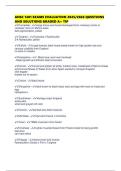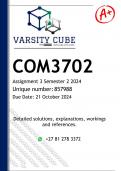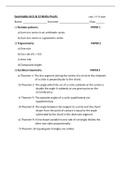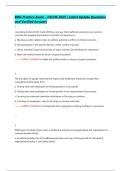CM1014
Giorgia Sisto Stuvia Summaries
Lectures Week 1-8
Tutorial 1-8
Mock Exam Questions + Flashcards
1. Introducing Organizational Communication
2. Fordism and Organizational Communication
3. Organizational Culture
4. Power and Resistance at Work
5. The Post-Fordism Workplace
6. Leadership Communication
7. Organizational Branding
8. Global and Multicultural Contexts
Notes via Stuvia, Giorgia Sisto 1
,YELLOW: THEORIES/DEFINITIONS
IMPORTANT PEOPLE
QUESTIONS
Notes via Stuvia, Giorgia Sisto 2
, Introducing Organizational Communication, #1 week
#1.1 LECTURE
A majority part of our lives is led by organizations.
WHY STUDYING THIS COURSE? “Human beings are organizational animals; modern life is defined by
organizations and corporations (we interact with)”.
● Organizations give meaning to our lives.
● Some organizations have become more powerful than governments.
● Organizations shape social reality through communication processes.
In this course we do not only focus on organizations but also on the way communication takes place
within organizations. This communication is complex. There are 3 types of communication within
organizations:
1. Line communication → very direct, from manager to subordinates or the other way around.
2. Parallel information → provided for supporting organizational communication
3. ‘Grapevine’ → gossips, informal communication, does not follow the rules of organizations,
personal understandings/ views, it is considered to be the hidden part of communication
Communication barriers in the modern workplace: time pressure; unclear responsibilities; lack of strong
leadership; different communication styles.
#1.2 LECTURE
Central questions for today…..
1. WHAT IS ORGANIZATION?
There is not a single definition to describe organizations.
Thinking of it in terms of metaphors we can think of: a tribe, a machine (operational aspect), a pyramid
(hierarchical structure of organizations), a zoo, a story, a family, a community, a political system.
However, metaphors just highlight some aspects of organizations and don’t give a definition of the
concept itself.
Some organizations even make clear statements about their visions how their organization should look
like → NETFLIX
“We model ourselves on being a team, not a family. A family is about unconditional love, despite, say,
your siblings’ bad behavior. A dream team is about pushing yourself to be the best teammate you can
be, caring intensely about your teammates, and knowing that you may not be on the team forever”.
Charles Redding → founder of organizational communications. Instead of giving one definition, here the
4 key features of every organization:
1. Interdependence (responsibility is a shared value, reliability of individuals, teamwork)
2. Differentiation of tasks and functions (division of labor, roles, and responsibilities)
Notes via Stuvia, Giorgia Sisto 3
, 3. Goal orientation (for everyone to strive toward)
4. Control (to achieve coordinated, goal-oriented behavior) → mechanisms of control. Control
never disappears from an organization.
(5.) Communication is not mentioned in the 4 key features BUT it is important because it defines
new norms, rules, it establishes relationships.
Trends of communication during the pandemic:
- Digital communication became the new norm (transformation of most online works)
- Internal communication claimed organizations’ attention (find different ways to motivate
employees during these precarious times)
- Businesses showed empathy with others (e.g. Burger King saying to buy from McDonald’s)
#1.3 LECTURE
Organizations are not static elements, instead they are dynamic. Many elements after the pandemic are
still relevant but have been altered (e.g. structure, organization types, goal/s, communication, control).
2. WHAT IS ORGANIZATIONAL COMMUNICATION?
There are 2 perspectives:
● Communication IN organizations (transmission model) → THIS MODEL FAILS: S - M - C -
R model. Sender, Message, Channel, Receiver
○ Organizations as containers for communication processes.
○ Focus: efficiency and clarity.
○ Communication only occurs in organizations.
○ Overlooking the complexity of the communication process (problems caused by
communication: interpretation, misunderstandings, knowledge).
● Organizations AS Communication (constitutive approach [meaning]) → APPROVED BY
OUR BOOK
○ Communication constitutes organization. Organizations are about creating and
interpreting meanings.
○ Without communication, organizations cease to exist.
○ Organizations as complex patterns of communication habits.
○ Drawback: if every meaning needs to be negotiated, we can not always take the efficiency
as the primary goal of the organization (since negotiation of meaning requires some time)
Notes via Stuvia, Giorgia Sisto 4










